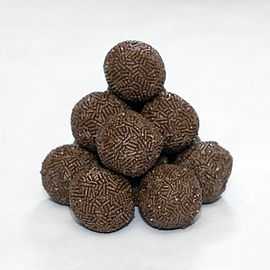Rum ball
| Rum ball | |
|---|---|
| Dessert | |
 | |
| Main ingredient(s): | |
| Cake or biscuit material, cocoa, binding ingredient (jam or condensed milk), chocolate, rum | |
| Recipes at Wikibooks: | |
|
| |
| Media at Wikimedia Commons: | |
|
|
Rum balls (German: Rumkugeln, Punschkugeln) are a truffle-like confection of sweet, dense balls flavoured with chocolate and rum. They are roughly the size of a golf ball and often coated in chocolate sprinkles, desiccated coconut, or cocoa. As their name implies, these cookies contain rum. Because they are not baked, the alcohol flavour and kick are not lost during baking. This cookie is especially popular during the holiday season.

Rum balls are a popular Christmas snack in England, Australia, Canada, New Zealand, the United States, Denmark (called Romkugle, but is enjoyed all year round), Austria, Slovenia, Hungary, and the Czech Republic.
There are many different ways to make rum balls, as recipes vary from region to region and family to family. All rum balls must include chocolate and rum, but the rest of the ingredients vary in kind, form, and amount.
To make a rum ball, the cake (or biscuit) material is crushed and mixed with cocoa and a moist binding ingredient, such as jam or condensed milk. Other optional ingredients can also be added, such as nuts. When the mixture holds together firmly, it is rolled into balls and then coated.
In Hungary they are made in a similar way, but usually rolled in sugar. Ground walnut and raisins are sometimes added to the rum ball ingredients. Some Hungarian rum balls are made with whole cherries placed inside the balls, and then rolled in coconut flakes (Hungarian: kókuszgolyó).
Rum balls closely resemble brigadeiros, a Brazilian sweet; however, brigadeiros are made from condensed milk.
See also
References
Further reading
- Lovegren, Sylvia. Fashionable Food: Seven Decades of Food Fads. New York: Macmillan, 1995. ISBN 0-226-49407-1.
External links
| Wikibooks has a book on the topic of: Cookbook:Rum balls |
| Wikimedia Commons has media related to Rum balls. |